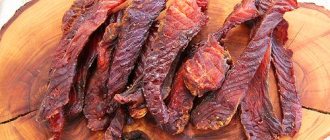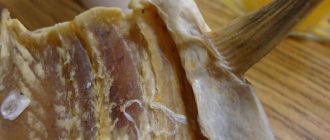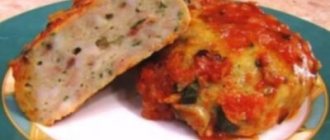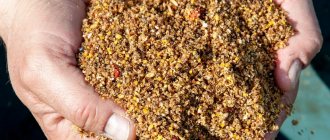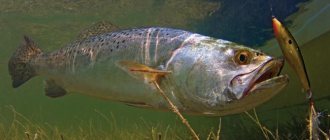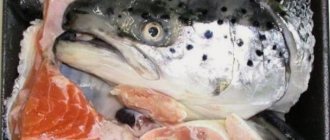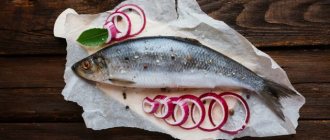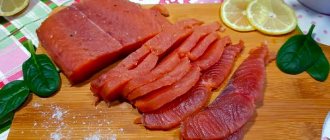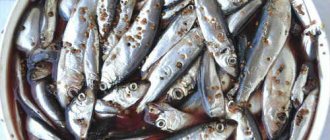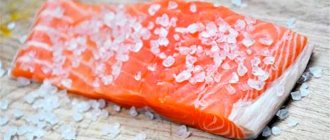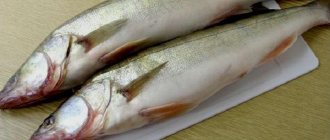Balyk from carp
Dried meat is not inferior in taste to regular meat and is suitable as a snack for alcohol or a nutritious snack for a long hike in nature.
It is most rational to use large fish weighing more than 5 kilograms for salting. According to all criteria, balyk made from carp is excellent. You won’t have to suffer for a long time choosing small bones, as happens with carp, and the flesh of even the largest representative of this species does not absorb the smell of mud at all, unlike catfish. Therefore, it is very easy to prepare balyk from carp at home.
Dried carp straws
This is a delicious snack. It is eaten even by those who do not like the taste of dried and dried fish.
1 kg of dried carp straws in the store costs more than one thousand rubles. An undeniable convenience is vacuum packaging, which preserves taste and freshness for a long time.
It is more profitable and easier to prepare the straws yourself. You won't have to worry about long-term storage. It is so tasty that it is quickly eaten. It's nice to just have a snack when you feel hungry. Beer lovers find special use for it.
Straws are easy to make from any type of fish.
Making straws from dried carp
Take dried (semi-finished) dried fish. The spine is removed from it if this is not done before drying. The ribs and small bones are left - they will practically not be felt as a hindrance. But you can remove them if they annoy someone. Using a sharp knife, the fillet is cut along the backs into long and thin strips.
Then the straws are placed on large plates in a heap, without pressing or compacting. And dry to a pleasant condition. Store in paper bags in small containers.
Preparing fish for salting
To achieve success, you need not only a good recipe, but also an understanding of how to make balyk. This will require several successive steps, the first of which will be cutting the carp into balyk.
- As with any other fish, cut off the head and tail, and then discard the entrails and fins.
- A good flush will help remove all unpleasant films and other intestinal debris. If you are afraid that the unique taste will be “washed out,” you can simply go over the fillet well with a paper towel.
- After making an incision on the back, flatten the fish and cut into small pieces of 2-3 centimeters.
Dry salted carp
I immediately remembered the treasured recipe, it is a little different from salting other types of fish! To process and cut any large fish, you will need a minimum set of tools: 1. Scale cleaner 2. Chopping knife 3. Kitchen hatchet 4. Secateurs for removing fins 5. Rubber hammer 1. First of all, you need to clean the carp, cut off all the fins with pruners, gut the insides and wash well from the blood. 2. Then you need to chop off the head and tail, they will go to the ear, and chop the carcass crosswise using a hatchet and a rubber mallet into pieces 8-9 cm wide, about the size of your palm. What a color! Why not tuna!)) 3. Next, the pieces of fish should be soaked in cold water for 4-5 hours with the addition of a small amount of vinegar to better wash away the excess blood. I soaked it directly in the sink, the volume of water was about 12-15 liters, and for this volume I poured about a glass of vinegar over my eye. This is how unsightly the fish becomes after soaking 4. Then the fish must be salted, sprinkle each piece well with coarse, non-iodized salt, place in a suitable container, I usually salt the fish in food-grade plastic containers. Place in the refrigerator for 4 days. During this time, the fish will be salted and release its juice. After salting, the fish becomes like this 5. After 4 days, take the fish out, rinse off the salt and soak again in cold water for 4 hours, but without vinegar! 6. After 4 hours, hang the pieces in a cool, ventilated place for 2-3 days, no more, any balyk should not be overdried! Well, that’s it, the delicious carp balyk is ready! All that remains is to boil the potatoes in their jackets, pour over homemade sunflower oil, cut the rye bread, and pour a glass of light beer!))
IT IS IMPORTANT TO KNOW! Fishermen caught 25 kg of fish using the Fish XXL ! Read more.
Preparation
You will need several devices to make such dried fish that will be salted in all places and will not go rotten or spoil during storage. The more carefully you approach the process, the better the result will be.
- Salt. Large, preferably marine.
- Spices for fish - to your taste and according to your desire.
- A glass container that can accommodate the entire volume of fish.
- Oppression.
- Sterile (this is important) nylon thread.
- Gauze.
Place fillet pieces in a jar in portions, generously sprinkling each new layer with salt and seasonings. Having filled the entire jar in this way, move well, close and place in the refrigerator, placing pressure on top.
After three days, everything is ready for the second stage. Rinse all fish thoroughly under water and taste. If the salt is too noticeable on the tongue, you should soak the fillet in water for several hours - cold water will rid the fish of the abundance of salt.
Freezing is no less important than everything that happened before. The dried preparations are sent to the freezer. If any dangerous bacteria survived after salting, they will most likely die at low temperatures.
A day is enough. Do not neglect this stage even if you are confident in the quality of the caught fish - caution never hurt anyone, and you obviously don’t want to get an intestinal infection instead of a tasty dish.
The final step is wilting. Using a needle, thread the pieces of pulp onto the nylon thread one by one. After this, the “garland” needs to be hung in a dry, well-ventilated area.
A balcony or loggia is suitable for this, but if it is summer outside, it is better to additionally wrap each piece of fillet with gauze to protect it from flies. They are not only annoying, but also carry many dangerous infections, so it is better not to allow these insects to eat.
After two days of drying, the fillet is wrapped in parchment and sent to the refrigerator to ripen. At this time it becomes difficult to restrain yourself from trying, but believe me: a few more days of patience will be rewarded with soft, especially tasty meat.
How to cook peas for fishing?
When catching bream, crucian carp, carp and carp, peas can provide excellent assistance. There is an opinion among some fishermen that this is purely “bream food”, but this is far from the case. Try using it when fishing for carp and you will be rewarded. In addition, its low cost and ease of preparation can create a good alternative to ready-made bait.
A group of fishermen revealed the name of the secret bait during interrogation.
Category: regional news.
And the simultaneous use of peas as a bait and in groundbait will give even greater results. Properly cooking peas for use in the feeder and on the hook is not so easy.
We have selected two videos as an example of how you can use peas as a base in bait and as a bait on a hook or hair.
Read also: Do-it-yourself rabbit cage video drawings
Fish balyk at home
14.5k Views
Balyk is the back of the fish, its upper part. Fish balyk is fish that has been salted and dried in a special way.
Almost any river or sea fish is used for salting and drying fish, but special requirements are imposed on fish used for balyk. Its taste properties depend on what kind of fish is used to prepare balyk. Real balyk is prepared from valuable species of sturgeon and salmon fish - the so-called. balyk is made from sturgeon and red fish, but we will prepare it from any fish that is suitable in size.
What kind of fish goes for balyk
Any large fish whose meat has high and medium fat content is considered suitable for preparing balyk. Fatty fish with a small number of small fork bones is prized, but balyk can be made from almost any fish of sufficiently large size.
The most popular types of fish from which delicious balyk is made are asp, silver carp, catfish and carp. Balyk made from sturgeon and red fish from the salmon family will be very tasty. The fattest fish will be any fish caught in the autumn and early winter.
List of fish that make delicious balyk, grouped by popularity:
- Asp, ide, chub, bream;
- Silver carp;
- Catfish;
- Carp, carp, crucian carp;
- Mackerel, mackerel, tuna;
- Pike, zander;
- Chum salmon, pink salmon, trout, omul, whitefish, nelma, salmon;
- Sturgeon and sturgeon species of fish.
There is a fish on this list that cannot be considered a boneless fish and is not a fatty fish, but this does not mean that it cannot be used to make balyk. There will always be lovers of dietary lean meat, for example, pike or pike perch in the form of balyk.
The asp is at the top of this list not because it makes the most delicious balyk, but because it more often ends up in the hands of the fisherman as a trophy. This is a rather bony fish, and when the question arises of how to cook it, two options come to mind: mince it and fry the cutlets, or make balyk and then deal with the bones - it is much more convenient to do this in dried fish than in cooked in a different way.
The fish from which balyk is prepared can be divided by size into medium, large and very large. Medium-sized fish is used for balyk almost entirely, and large ones undergo preliminary cutting - it is divided into tesha and the balyk itself. Very large fish is cut into pieces.
Cooking balyk
There are a huge variety of ways to prepare balyk, and there is always the possibility of improvisation, but there are also common principles that you should try to follow.
Fish balyk is divided by type of fish, size, salting method, type and degree of drying of fish meat. Cold smoked balyk (drying fish in cooled smoke) turns out to be very tasty, but it cannot be prepared at home.
Subtleties of cooking
- Large fish are flattened on the side and cut for uniform salting and drying;
- A not very large fish is flattened along the ridge without ripping open the belly, the head and tail are not removed, only the gills and entrails are removed;
- Very large fish are filleted, which is cut into pieces from which the balyk is prepared separately from the meat;
- To speed up the process of preparing balyk, the skin of the fish is removed;
- If the fish is fished in pieces, their size should be large, but in moderation - small pieces dry out quickly, and too large pieces are poorly salted;
- The taste of balyk depends not only on the salting method, but also on the degree of drying - the drier the fish meat, the saltier it is;
- The salt that is used for salting fish should be coarse without foreign impurities;
- After salting, the fish should be soaked for as many hours as the number of days it was in the brine;
- To obtain the spicy taste of balyk, at the stage of salting the fish, up to ½ part of sugar (usually 20-30%) and spicy spices (allspice, nutmeg, bay leaf, black peppercorns, coriander, cloves, ginger and others) are added to the salt. .
Recipes for salting carp
There are many recipes with different ways of preparing salted and lightly salted carp at home, there are both complex options and quite simple ones. But in fact all of them are divided into two types - dry pickling and in brine.
Dry salting
6 3 days/30 min.
- ground black pepper
4-5 g
Nutritional value per 100 g:
- Clean the fish, remove the head and tail, cut into two pieces, remove the backbone.
- Cut the fillet into portions 2 to 3 cm wide.
- Mix salt thoroughly with sugar and spices.
- Place the pieces of fish in a container with holes on the sides and cover with the resulting mixture.
- Place in a cold place under pressure for 3 days (the container should be placed in a basin, the resulting liquid will flow into it). Stir once every day.
- Remove from the container, rinse under running water, and dry on a towel.
Did you know? Carp are very sensitive to atmospheric changes; if the weather is rainy, they hide at the bottom of the river until the rain stops. This fish loves the sun's rays.
In brine
63 days/2.5 hours.
Nutritional value per 100 g:
- Clean the fish, remove the insides, fins, head and tail.
- Cut the carcass into two pieces, remove the backbone.
- Mix the salt and sugar thoroughly, squeeze the garlic into the mixture using a garlic press and stir again.
- In a solid container, make a layer of the mixture, lay the fish fillets in layers, sprinkling them with salt, sugar and garlic, put a bay leaf between the pieces.
- Leave in a cool place for 3-5 days. The brine is formed within a day.
- Stir the fish once a day.
- Take out, soak in water for 1-2 hours, dry on a towel.
Important! For salting, it is best to use sea salt.
Preparing this dish will not take much time, but it will be pleasant to later enjoy with beer or use as one of the components of holiday sandwiches.
Was this article helpful?
Thank you for your opinion!
Write in the comments what questions you have not received an answer to, we will definitely respond!
You can recommend this article to your friends!
Already helped 16 times
Balyk recipes
Regardless of what kind of fish is used, you can always cook balyk according to a universal recipe. This is not a classic recipe, but adapted for quick preparation of balyk. The secret of delicious balyk lies in following the principles we talked about above.
Simple recipe
We will use a recipe in which the fish is salted in brine. This is the simplest option that allows you to achieve the right taste of balyk, even if you have never cooked it. This way you can bait almost any fish. So let's get started...
What you will need:
- Fatty or medium-fat fish of medium or large size;
- Salt and sugar;
- Spices and seasonings for fish.
For one kilogram of fish you will need: salt - 150 grams, sugar - 30-50 grams. As spices, you can always use allspice and coarse black pepper, bay leaf, coriander, cloves (with caution).
Main stages:
1. Cutting fish; 2. Salting fish in brine; 3. Drying salted fish.
Preparation:
- Clean the fish from scales and remove the entrails;
- Cut off the excess - head, tail, fins;
- Cut the fish into halves along the spine;
- Remove the ridge and cut the fish into pieces 1.5-3 cm thick;
- Sprinkle the pieces of fish with a mixture of sugar and salt, add spices, mix;
- Cover the salted fish with a lid on which to place a small load;
- Place the container with fish in the refrigerator for 4-7 days for salting;
- Remove the fish from the refrigerator, rinse with cold water;
- Pour clean cold water over the fish and let it free itself from excess salt for 2-5 hours;
- Drain the water, let the remaining water drain and hang the fish to dry in a cool, dry, ventilated place, protected from the sun and insects.
After just a couple of days, the fish needs to be checked for the degree of dryness. Thin pieces of fish will be ready earlier, while larger pieces will take longer to dry.
When the degree of drying suits you, you can consider that the fish balyk is completely ready. It can be served at the table, or sent to the refrigerator for storage.
We talked in detail about how to properly store cooked fish in an article devoted to how to properly salt and dry fish.
Classic recipe
Classic balyk is made from sturgeon or fish from the salmon family. The fish is cut into balyk and tesha. If this is freshly caught fish, it will have to undergo a long salting stage for one and a half months - this is required by established standards. Thawed fish is salted much faster. See more details in the video:
Silver carp balyk
Silver carp grows to impressive sizes; it can be classified as a very large fish, which requires cutting the carcass into pieces. Silver carp balyk can be made as shown in the video below:
Balyk from carp
Like silver carp, carp grows to impressive sizes, and if you have a very large carp in your hands, you will have to cut it up in a special way.
In general, the technology for preparing balyk from carp is similar to those described above. For a diagram of cutting carp and a recipe for salting, see the following video:
Mackerel balyk
The following recipe will help us prepare mackerel like balyk.
Required:
- Mackerel - 3 pcs;
- Salt - 1 tbsp. heaped spoon;
- Sugar - 1 tbsp. spoon;
- Dry mustard - 1 tbsp. spoon.
Preparation:
- Cut the mackerel into sides or fillets, remove the backbone and bones;
- Prepare the curing mixture (sugar, salt and mustard) and rub the mackerel fillet with it;
- Place the salted fish halves in a container, cover with a lid and place in the refrigerator for a day;
- After 24 hours, take the fish out of the refrigerator, rinse with water and dry with a paper towel;
- We hang the mackerel fillets for drying.
Lightly salted carp (carp)
After all, fish is a source of building materials for metabolism in the human body. If carp is treated with salt, it will acquire special taste properties. Therefore, we introduce you to how to salt carp.
Salting carp recipe
Salting any fish (including carp) at home can be dry or wet. Only coarse salt is always used for it. But it does not add flavor to the fish, it only removes moisture from it. The general rule before salting is to pre-prepare the fish. She needs to be gutted. And now we’ll talk about specific options for how to salt carp.
How to salt carp at home - wet salting
- In order to salt carp, we wash the gutted fish with water and place it in layers in a container that does not oxidize. For example, it could be an enamel pan. Sprinkle each layer with salt (1 kg of salt per 10 kg of fish).
- If you want the carp to have a special delicate taste, you can add a tablespoon of sugar to the salt.
- We place a wooden circle on the carp and place a three-liter jar of water on it (pressure). We put the fish at home in a cool place.
- After about 10-12 hours, juice will appear in the pan. We leave it until the end of the carp salting process.
- We remove the oppression after 4 days. We wash the carp in running cold water and pour out the juice. Next, we dry it and put it in a wooden box or basket for storage.
- When salting carp, consider the size of the fish. If these are small carps weighing less than 100 grams, they will be ready at home in 2-3 days. If the carps are medium (100-250 grams), it will take 5-10 days. If these are large carp (500-800 grams), salting at home will take 7-10 days.
- Wet salting of carp can be slightly varied. To do this, prepare a salt solution (for 1 kg of salt - 3 liters of water) and pour it into the fish in the container. This type of wet salting is mainly used for salting small carp at home.
Read also: Melba's daughter description photo reviews
How to salt carp at home - dry salting
- To salt carp, place it in layers in a wooden box or basket. The bottom, if you salt the carp, should be covered with burlap or a clean canvas rag. The fish is laid tightly - head to tail.
- Sprinkle each layer of carp with salt (1.5 kg of salt per 10 kg of fish).
- We place a wooden lid on top of the fish and put pressure on it. This could be a large stone or a three-liter jar of water.
- Thanks to this, the carp that you will salt will begin to release juice. It will drain through holes in the basket or between the boards of the box.
- At home, carp should be kept in a cool place. In 5-10 days, the salted carp will be ready.
Video with recommendations for salting carp at home
Much more often you can find already gutted freshwater fish on sale. And besides, if a whole fish ends up in the kitchen, then much more often the caviar is thrown away along with other entrails, since not many people know that it is possible to prepare a large number of interesting dishes from it. Now we will advise you on recipes for making delicious cutlets from fish roe. Fans of fish dishes will definitely appreciate them.
Silver carp caviar cutlets
- raw silver carp caviar – 0.5 kg;
- eggs – 1 pc.;
- carrots – 100 g;
- onion – 200 g;
- semolina – 2 tbsp. spoons;
- vegetable oil for frying;
- salt, suneli hops, ground ginger - to taste.
We wash the caviar, remove the scales, if any, and the films. Finely chop the onion and place it in the prepared caviar. Three carrots on a small grater and add them to the rest of the ingredients. Add egg, semolina, salt to taste, spices and beat everything with a blender. Scoop the mass with a tablespoon and place it in a frying pan with heated vegetable oil. Fry the cutlets on both sides until cooked.
Carp caviar cutlets
- carp caviar – 400 g;
- onion – 1 pc.;
- garlic – 3 cloves;
- soda – 0.5 teaspoon;
- flour – 50 g;
- salt and dark ground pepper - to taste;
- vegetable oil for frying.
We thoroughly wash the caviar under running water and clear it of films. Chop the onion and pass the garlic through a press. Add vegetables to the caviar, salt and pepper, add flour, soda and mix well. Heat the vegetable oil in a frying pan, add the dough with a tablespoon and fry the fish cutlets on both sides until golden brown.
Carp caviar cutlets
- peeled carp caviar – 500 g;
- onion – 1 pc.;
- eggs – 2 pcs.;
- flour - 3 tbsp. spoons;
- salt, spices - to taste;
- vegetable oil.
Pour hot water over the caviar and rinse it a couple of times, draining and adding water again until it becomes clear. Grind the caviar through a colander. This is why the eggs will separate well from the films.
Balyk from carp
Dried meat is not inferior in taste to regular meat and is suitable as a snack for alcohol or a nutritious snack for a long hike in nature. It is most rational to use large fish weighing more than 5 kilograms for salting. According to all criteria, balyk made from carp is excellent.
You won’t have to suffer for a long time choosing small bones, as happens with carp, and the flesh of even the largest representative of this species does not absorb the smell of mud at all, unlike catfish. Therefore, it is very easy to prepare balyk from carp at home.
Preparing fish for salting
To achieve success, you need not only a good recipe, but also an understanding of how to make balyk. This will require several successive steps, the first of which will be cutting the carp into balyk.
- As with any other fish, cut off the head and tail, and then discard the entrails and fins.
- A good flush will help remove all unpleasant films and other intestinal debris. If you are afraid that the unique taste will be “washed out,” you can simply go over the fillet well with a paper towel.
- After making an incision on the back, flatten the fish and cut into small pieces of 2-3 centimeters.
Preparation
You will need several devices to make such dried fish that will be salted in all places and will not go rotten or spoil during storage. The more carefully you approach the process, the better the result will be.
- Salt. Large, preferably marine.
- Spices for fish - to your taste and according to your desire.
- A glass container that can accommodate the entire volume of fish.
- Oppression.
- Sterile (this is important) nylon thread.
- Gauze.
Place fillet pieces in a jar in portions, generously sprinkling each new layer with salt and seasonings. Having filled the entire jar in this way, move well, close and place in the refrigerator, placing pressure on top.
After three days, everything is ready for the second stage. Rinse all fish thoroughly under water and taste. If the salt is too noticeable on the tongue, you should soak the fillet in water for several hours - cold water will rid the fish of the abundance of salt.
Freezing is no less important than everything that happened before. The dried preparations are sent to the freezer. If any dangerous bacteria survived after salting, they will most likely die at low temperatures.
A day is enough. Do not neglect this stage even if you are confident in the quality of the caught fish - caution never hurt anyone, and you obviously don’t want to get an intestinal infection instead of a tasty dish.
The final step is wilting. Using a needle, thread the pieces of pulp onto the nylon thread one by one. After this, the “garland” needs to be hung in a dry, well-ventilated area.
A balcony or loggia is suitable for this, but if it is summer outside, it is better to additionally wrap each piece of fillet with gauze to protect it from flies. They are not only annoying, but also carry many dangerous infections, so it is better not to allow these insects to eat.
After two days of drying, the fillet is wrapped in parchment and sent to the refrigerator to ripen. At this time it becomes difficult to restrain yourself from trying, but believe me: a few more days of patience will be rewarded with soft, especially tasty meat.
